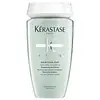What's inside
What's inside
 Key Ingredients
Key Ingredients

No key ingredients
 Benefits
Benefits

 Concerns
Concerns

 Ingredients Side-by-side
Ingredients Side-by-side

Water
Skin ConditioningSodium Laureth Sulfate
CleansingTea-Lauryl Sulfate
CleansingCocamide Mipa
EmulsifyingDisodium Cocoamphodiacetate
CleansingGlycol Distearate
EmollientHexylene Glycol
EmulsifyingSodium Chloride
MaskingCitric Acid
BufferingSodium Benzoate
MaskingSodium Hydroxide
BufferingCapryloyl Glycine
CleansingPolyquaternium-11
Salicylic Acid
MaskingCarbomer
Emulsion StabilisingPyridoxine Hcl
Skin ConditioningMenthoxypropanediol
MaskingGuar Hydroxypropyltrimonium Chloride
Skin ConditioningHexyl Cinnamal
PerfumingLinalool
PerfumingHydroxycitronellal
PerfumingCitronellol
PerfumingBenzyl Alcohol
PerfumingFumaric Acid
BufferingParfum
MaskingWater, Sodium Laureth Sulfate, Tea-Lauryl Sulfate, Cocamide Mipa, Disodium Cocoamphodiacetate, Glycol Distearate, Hexylene Glycol, Sodium Chloride, Citric Acid, Sodium Benzoate, Sodium Hydroxide, Capryloyl Glycine, Polyquaternium-11, Salicylic Acid, Carbomer, Pyridoxine Hcl, Menthoxypropanediol, Guar Hydroxypropyltrimonium Chloride, Hexyl Cinnamal, Linalool, Hydroxycitronellal, Citronellol, Benzyl Alcohol, Fumaric Acid, Parfum
Water
Skin ConditioningVinegar
Rubus Idaeus Fruit Extract
AstringentParfum
MaskingOctyldodeceth-16
EmulsifyingPEG-60 Hydrogenated Castor Oil
EmulsifyingAlcohol
AntimicrobialGlycerin
HumectantButylene Glycol
HumectantCetrimonium Chloride
AntimicrobialCaprylyl Glycol
EmollientPolyquaternium-7
1,2-Hexanediol
Skin ConditioningDisodium EDTA
Sodium Citrate
BufferingSodium Benzoate
MaskingPentylene Glycol
Skin ConditioningEthylhexylglycerin
Skin ConditioningOctanediol
Raspberry Seed Oil/Tocopheryl Succinate Aminopropanediol Esters
Skin ConditioningLavandula Angustifolia Extract
Skin ConditioningMelaleuca Alternifolia Leaf Extract
PerfumingRosmarinus Officinalis Leaf Extract
AntimicrobialSaccharomyces Ferment Filtrate
HumectantHydrolyzed Corn Protein
Skin ConditioningHydrolyzed Soy Protein
HumectantHydrolyzed Wheat Protein
Skin ConditioningPhenoxyethanol
PreservativeWater, Vinegar, Rubus Idaeus Fruit Extract, Parfum, Octyldodeceth-16, PEG-60 Hydrogenated Castor Oil, Alcohol, Glycerin, Butylene Glycol, Cetrimonium Chloride, Caprylyl Glycol, Polyquaternium-7, 1,2-Hexanediol, Disodium EDTA, Sodium Citrate, Sodium Benzoate, Pentylene Glycol, Ethylhexylglycerin, Octanediol, Raspberry Seed Oil/Tocopheryl Succinate Aminopropanediol Esters, Lavandula Angustifolia Extract, Melaleuca Alternifolia Leaf Extract, Rosmarinus Officinalis Leaf Extract, Saccharomyces Ferment Filtrate, Hydrolyzed Corn Protein, Hydrolyzed Soy Protein, Hydrolyzed Wheat Protein, Phenoxyethanol
 Reviews
Reviews

Ingredients Explained
These ingredients are found in both products.
Ingredients higher up in an ingredient list are typically present in a larger amount.
Parfum is a catch-all term for an ingredient or more that is used to give a scent to products.
Also called "fragrance", this ingredient can be a blend of hundreds of chemicals or plant oils. This means every product with "fragrance" or "parfum" in the ingredients list is a different mixture.
For instance, Habanolide is a proprietary trade name for a specific aroma chemical. When used as a fragrance ingredient in cosmetics, most aroma chemicals fall under the broad labeling category of “FRAGRANCE” or “PARFUM” according to EU and US regulations.
The term 'parfum' or 'fragrance' is not regulated in many countries. In many cases, it is up to the brand to define this term.
For instance, many brands choose to label themselves as "fragrance-free" because they are not using synthetic fragrances. However, their products may still contain ingredients such as essential oils that are considered a fragrance by INCI standards.
One example is Calendula flower extract. Calendula is an essential oil that still imparts a scent or 'fragrance'.
Depending on the blend, the ingredients in the mixture can cause allergies and sensitivities on the skin. Some ingredients that are known EU allergens include linalool and citronellol.
Parfum can also be used to mask or cover an unpleasant scent.
The bottom line is: not all fragrances/parfum/ingredients are created equally. If you are worried about fragrances, we recommend taking a closer look at an ingredient. And of course, we always recommend speaking with a professional.
Learn more about ParfumSodium Benzoate is a preservative. It's used in both cosmetic and food products to inhibit the growth of mold and bacteria. It is typically produced synthetically.
Both the US FDA and EU Health Committee have approved the use of sodium benzoate. In the US, levels of 0.1% (of the total product) are allowed.
Sodium benzoate works as a preservative by inhibiting the growth of bacteria inside of cells. It prevents the cell from fermenting a type of sugar using an enzyme called phosphofructokinase.
It is the salt of benzoic acid. Foods containing sodium benzoate include soda, salad dressings, condiments, fruit juices, wines, and snack foods.
Studies for using ascorbic acid and sodium benzoate in cosmetics are lacking, especially in skincare routines with multiple steps.
We always recommend speaking with a professional, such as a dermatologist, if you have any concerns.
Learn more about Sodium BenzoateWater. It's the most common cosmetic ingredient of all. You'll usually see it at the top of ingredient lists, meaning that it makes up the largest part of the product.
So why is it so popular? Water most often acts as a solvent - this means that it helps dissolve other ingredients into the formulation.
You'll also recognize water as that liquid we all need to stay alive. If you see this, drink a glass of water. Stay hydrated!
Learn more about Water